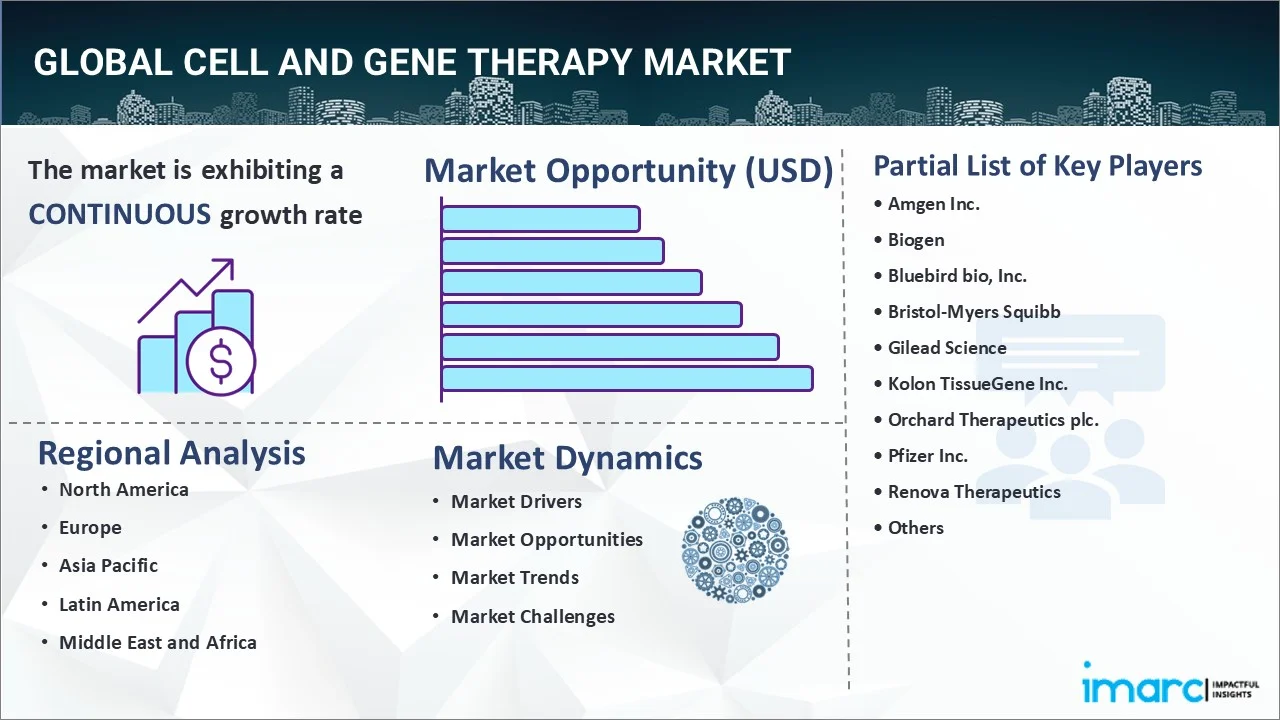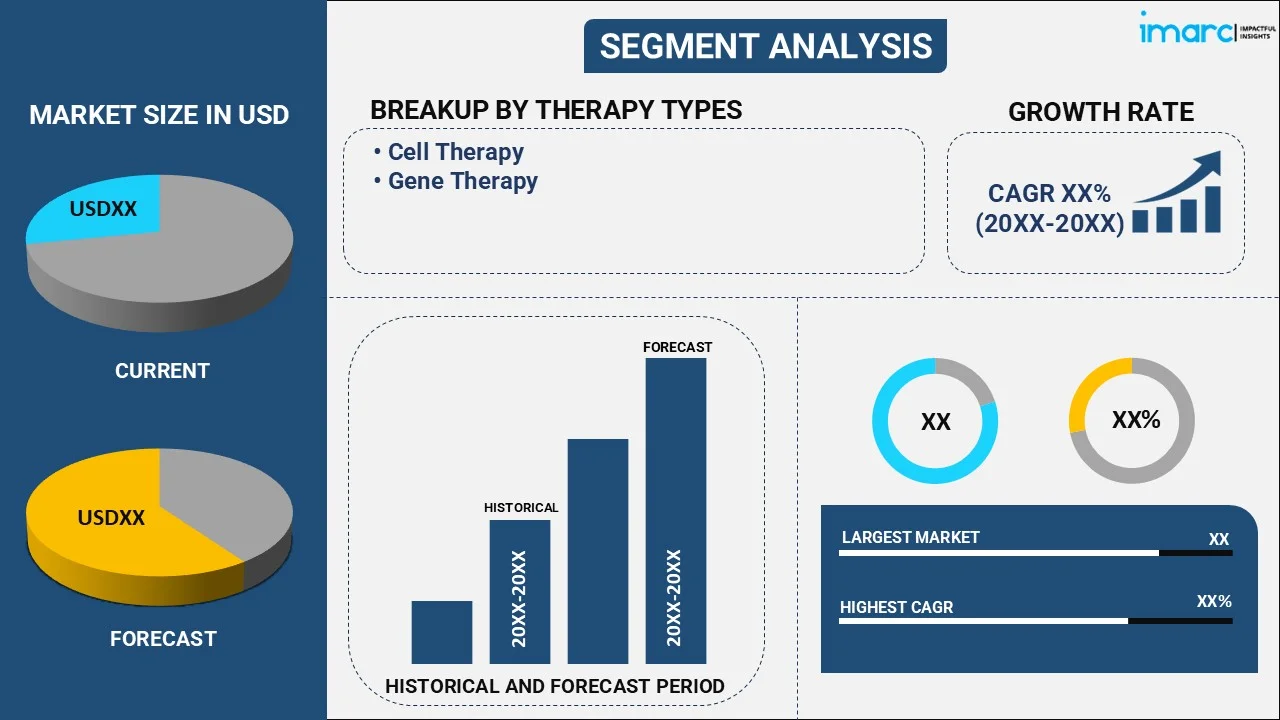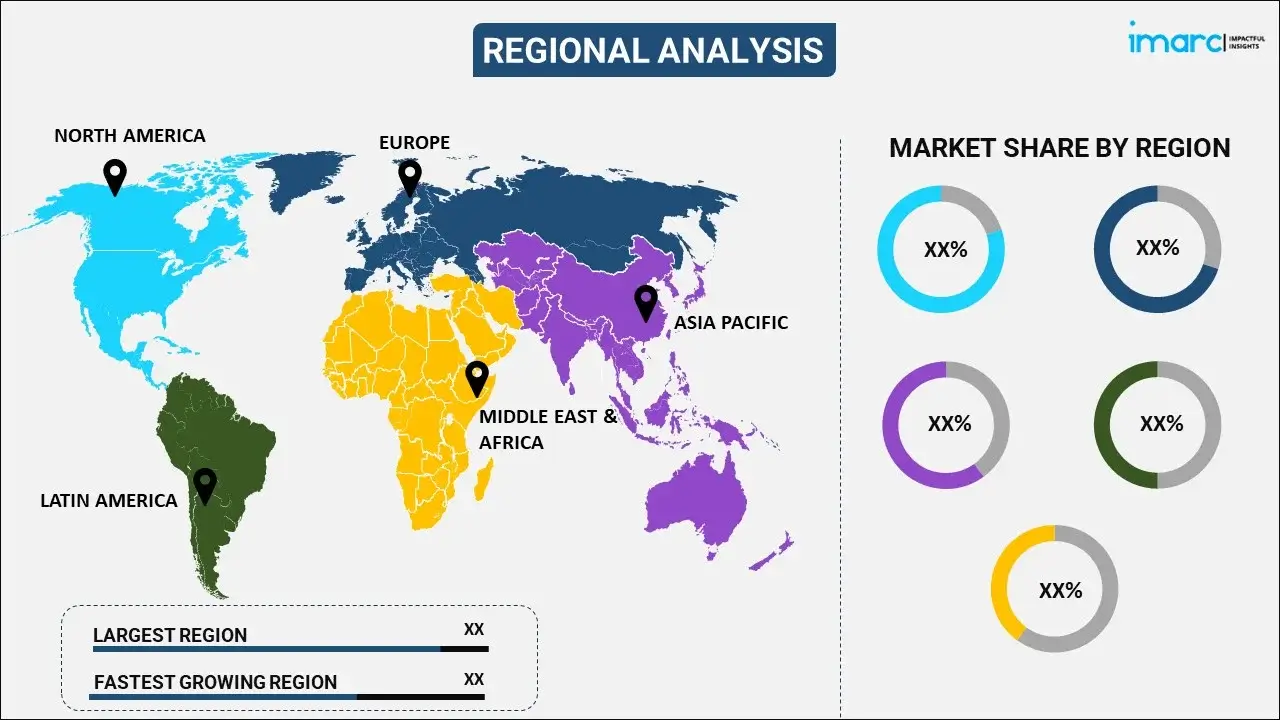
Cell and Gene Therapy Market by Therapy Type (Cell Therapy, Gene Therapy), Indication (Cardiovascular Disease, Oncology Disorder, Genetic Disorder, Infectious Disease, Neurological Disorder, and Others), Delivery Mode (In-Vivo, Ex-Vivo), End User (Hospitals, Cancer Care Centers, Pharmaceutical & Biotechnology Companies, and Others), and Region 2025-2033
Market Overview:
The global cell and gene therapy market size is projected to exhibit a growth rate (CAGR) of 14.88% during 2025-2033. Rapid advancements in biotechnology and genetic research, the rising prevalence of chronic diseases, supportive regulatory frameworks and streamlined approval processes, collaborations among industry players, growing awareness among healthcare providers and patients, and burgeoning investments in manufacturing infrastructure are factors propelling the market growth.
|
Report Attribute
|
Key Statistics
|
|---|---|
|
Base Year
|
2024 |
|
Forecast Years
|
2025-2033 |
|
Historical Years
|
2019-2024
|
| Market Growth Rate (2025-2033) | 14.88% |
Cell and gene therapy represents cutting-edge medical approaches that harness the potential of human cells and genes to treat a wide range of diseases and conditions. In cell therapy, living cells are transplanted or manipulated to replace or repair damaged tissues, while gene therapy involves the alteration, introduction, or removal of genetic material to correct faulty genes. These revolutionary therapies have garnered considerable attention due to their potential to revolutionize healthcare. The advantages of cell and gene therapy are manifold, such as they offer personalized treatment options, tailored to an individual's unique genetic makeup, increasing the likelihood of successful outcomes. Furthermore, these therapies hold promise for addressing previously untreatable or incurable diseases, such as certain types of cancer, genetic disorders, and autoimmune conditions. By promoting tissue regeneration and enhancing immune responses, cell and gene therapies have the ability to provide long-lasting and potentially curative effects. The applications of cell and gene therapy span various medical disciplines, including oncology, neurological disorders, and the field of regenerative medicine.

The global cell and gene therapy market is influenced by rapid advancements in biotechnology and genetic research, which have paved the way for innovative therapies, attracting significant investments in the field. This is further bolstered by the burgeoning geriatric population and the prevalence of chronic diseases. Besides this, supportive regulatory frameworks and streamlined approval processes in various countries have facilitated market expansion. Additionally, increasing collaborations between pharmaceutical companies and research institutions have accelerated the development and commercialization of new therapies, which is creating a positive environment for the market. Furthermore, rising awareness among healthcare providers and patients about the benefits of these novel therapies has positively influenced market growth. Moreover, strategic alliances and partnerships among industry players and rapid technological advancements are supporting the market growth.
Cell and Gene Therapy Market Trends/Drivers:
Advancements in biotechnology and genetic research
Over the years, significant progress in understanding the fundamental mechanisms of genes and cells has allowed researchers to develop innovative therapeutic approaches. Utilizing cutting-edge tools like CRISPR-Cas9 gene editing and viral vector technologies, scientists can precisely modify genes and engineer cells for targeted treatments. These breakthroughs have enabled the development of novel therapies with the potential to treat previously incurable genetic disorders and chronic diseases. As biotechnological techniques continue to evolve, they offer promising avenues for further advancements in the field, attracting substantial investments from both public and private sectors.
Surging prevalence of chronic diseases and the burgeoning aging population
With an increasing number of individuals suffering from conditions like neurodegenerative disorders, cancer, and cardiovascular diseases, traditional treatment options often fall short in providing satisfactory outcomes. Cell and gene therapies offer the potential to address these unmet medical needs by introducing genetically modified cells or genetic material to repair, replace, or regenerate damaged tissues. The promise of targeted therapies tailored to an individual's genetic makeup has garnered attention from healthcare providers and patients alike, making cell and gene therapies a compelling option in the quest for better treatment solutions.
Supportive regulatory frameworks and streamlined approval processes
Recognizing the transformative potential of these therapies, regulatory authorities have been proactive in establishing guidelines to oversee their development, safety, and efficacy. Regulatory agencies, such as the U.S. Food and Drug Administration (FDA) and the European Medicines Agency (EMA), have implemented expedited pathways, such as the breakthrough therapy designation and accelerated approvals, to fast-track promising therapies. This supportive environment has fostered greater investor confidence, encouraged research and development efforts, and accelerated market entry for approved therapies. As a result, an increasing number of cell and gene therapies are gaining regulatory approvals, widening the scope of treatment options available to patients globally.
Key Market Segmentation:
IMARC Group provides an analysis of the key trends in each segment of the global cell and gene therapy market report, along with forecasts at the global, regional and country levels from 2025-2033. Our report has categorized the market based on therapy type, indication, delivery mode and end user.
Breakup Therapy Type:

- Cell Therapy
- Stem Cell
- Pluripotent Stem Cell
- Cancer Stem Cell
- Adult Stem Cell
- Non-Stem Cell
- T Cells
- Natural Killer
- Others
- Stem Cell
- Gene Therapy
The report has provided a detailed breakup and analysis of the market based on the therapy type. This includes cell therapy (stem cell {pluripotent stem cell, cancer stem cell, and adult stem cell} and non-stem cell {T cells, natural killer, and others}) and gene therapy.
In cell therapy, one significant driver is the continuous advancements in regenerative medicine and biotechnology. Researchers are harnessing the potential of stem cells and other cellular components to develop innovative therapies that can repair, replace, or regenerate damaged tissues and organs, offering promising treatment options for a wide range of diseases and injuries. Additionally, the growing prevalence of chronic conditions, such as cardiovascular diseases and neurodegenerative disorders, is fueling the demand for effective cell-based treatments. In the gene therapy segment, the ability to manipulate and modify genetic material holds immense potential. The advent of sophisticated gene-editing technologies like CRISPR-Cas9 has opened new avenues for precise and targeted therapeutic interventions. Gene therapies offer the possibility of curing genetic disorders by correcting or replacing defective genes, presenting a groundbreaking approach to previously incurable conditions. Furthermore, the increasing success and approval of gene therapies for certain diseases have instilled confidence in the medical community and attracted substantial investments in research and development.
Breakup by Indication:
- Cardiovascular Disease
- Oncology Disorder
- Genetic Disorder
- Infectious Disease
- Neurological Disorder
- Others
Oncology disorder holds the largest share in the market
A detailed breakup and analysis of the market based on the indication has also been provided in the report. This includes cardiovascular disease, oncology disorder, genetic disorder, infectious disease, neurological disorder, and others. According to the report, oncology disorder represented the largest segment.
The oncology disorder segment dominates the medical market due to several compelling reasons, which includes cancer being one of the leading causes of death worldwide. The escalating prevalence of various types of cancers, such as lung, breast, prostate, and colorectal cancer, contributes to the high demand for oncology treatments. Additionally, the rising incidence of cancer cases, particularly in aging populations, has led to an increased focus on cancer research and the development of innovative therapies.
Moreover, significant advancements in oncology research have resulted in the discovery of targeted therapies and immunotherapies, offering more effective and less toxic treatment options. In line with this, the growing awareness about early cancer detection and the importance of personalized treatment approaches have encouraged patient and physician engagement in oncology care. Furthermore, substantial investments from pharmaceutical companies, governments, and research institutions in cancer research and drug development further contribute to the dominance of the oncology disorder segment in the medical market.
Breakup by Delivery Mode:
- In-Vivo
- Ex-Vivo
The report has provided a detailed breakup and analysis of the market based on the delivery mode. This includes in-vivo and ex-vivo.
In the in-vivo segment, targeted delivery technologies have emerged as a prominent driver, enabling precise administration of therapeutic genes or cells directly into the patient's body. Advancements in viral vectors and nanoparticles have facilitated specific targeting of tissues or organs, further enhancing the therapeutic effect while minimizing off-target effects. On the other hand, in the ex-vivo segment, optimized cell manipulation and manufacturing processes drive progress. Innovations in genetic engineering techniques like CRISPR-Cas9 have enabled accurate modifications of cells before reinfusion, ensuring the delivery of genetically enhanced cells with enhanced therapeutic potential. Additionally, advancements in bioprocessing and cell culture technologies have improved scalability, quality control, and reproducibility, making ex-vivo therapies more accessible and commercially viable.
Breakup End User:
- Hospitals
- Cancer Care Centers
- Pharmaceutical & Biotechnology Companies
- Others
Hospitals hold the largest share in the market
A detailed breakup and analysis of the market based on the end user has also been provided in the report. This includes hospitals, cancer care centers, pharmaceutical & biotechnology companies, and others. According to the report, hospitals represented the largest segment.
The dominance of the hospitals segment in the cell and gene therapy market is being accelerated by the increasing awareness and acceptance of cell and gene therapies among healthcare professionals and patients. As more evidence of the efficacy and potential curative outcomes of these therapies emerges, hospitals are more inclined to incorporate them into their treatment offerings, leading to heightened demand. Additionally, advancements in medical research and technology have paved the way for the development of innovative therapies. Hospitals, being at the forefront of medical research and patient care, are quick to adopt these cutting-edge treatments, attracting more patients seeking novel and effective solutions. In line with this, strategic collaborations between hospitals, research institutions, and pharmaceutical companies to facilitate access to clinical trials, funding, and expertise, enabling hospitals to offer a wider range of cell and gene therapies is acting as another crucial growth-inducing factor. Moreover, favorable regulatory environments and streamlined approval processes for cell and gene therapies are favoring the market growth. Besides this, the growing prevalence of chronic diseases and genetic disorders worldwide has amplified the demand for personalized and targeted treatments, making hospitals a critical destination for patients seeking specialized care through cell and gene therapies.
Breakup by Region:

- North America
- United States
- Canada
- Europe
- Germany
- France
- United Kingdom
- Italy
- Spain
- Others
- Asia Pacific
- China
- Japan
- India
- South Korea
- Australia
- Indonesia
- Others
- Latin America
- Brazil
- Mexico
- Others
- Middle East and Africa
North America exhibits a clear dominance, accounting for the largest cell and gene therapy market share
The market research report has also provided a comprehensive analysis of all the major regional markets, which include North America (the United States and Canada); Europe (Germany, France, the United Kingdom, Italy, Spain, and others); Asia Pacific (China, Japan, India, South Korea, Australia, Indonesia, and others); Latin America (Brazil, Mexico, and others); and the Middle East and Africa. According to the report, North America was the largest market.
North America's dominant position in the global cell and gene therapy market can be attributed to the robust investments in research and development activities by both private and public entities, which is propelling innovation and driving the advancement of new therapies. Additionally, supportive regulatory policies and streamlined approval processes have facilitated market entry for cell and gene therapies, thereby favoring the market growth in the region. In line with this, North America boasts a well-established healthcare infrastructure and a high prevalence of chronic diseases, providing a fertile ground for the adoption of cell and gene therapies. The region's sophisticated healthcare system and trained medical professionals contribute to the effective integration and delivery of these advanced treatments. Furthermore, strong collaborations between academia, research institutions, and pharmaceutical companies have promoted knowledge-sharing and accelerated the development of new therapies. This collaborative ecosystem fosters a vibrant and dynamic market landscape. Moreover, growing awareness among patients and healthcare providers about the benefits of cell and gene therapies has increased the acceptance and demand for these treatments in the region. The potential for personalized and curative therapies has garnered significant attention and interest.
Competitive Landscape:
The competitive landscape of the cell and gene therapy market is characterized by a dynamic and rapidly evolving ecosystem. Numerous players, including pharmaceutical companies, biotechnology firms, research institutions, and startups, are actively engaged in this space. These entities strive to carve out their niche by leveraging cutting-edge technologies, developing innovative therapies, and establishing strategic partnerships. Additionally, academic collaborations and clinical research initiatives contribute to the proliferation of knowledge and expertise within the field. The market's competitive intensity is further fueled by ongoing investments in research and development, manufacturing capabilities, and regulatory compliance. With the potential for transformative medical advancements, companies vie to secure a strong position in this burgeoning market. As regulatory approvals and commercialization efforts accelerate, the competitive landscape is poised to witness continuous evolution, shaping the future of cell and gene therapy on a global scale.
The report has provided a comprehensive analysis of the competitive landscape in the market. Detailed profiles of all major companies have also been provided. Some of the key players in the market include:
- Amgen Inc.
- Biogen
- Bluebird bio, Inc.
- Bristol-Myers Squibb
- Gilead Science
- Kolon TissueGene Inc.
- Orchard Therapeutics plc.
- Pfizer Inc.
- Renova Therapeutics
- Spark Therapeutics, Inc.
Recent Developments:
- In March 2023, Sparks Therapeutics stated work on its USD 575m gene therapy innovation center in Philadelphia.
- In August 2023, Kolon TissueGene raised $29.6 million in building cell and gene therapy to initially target osteoarthritis of the knee.
- In June 2023, Amgen announced that the U.S. Food and Drug Administration (FDA) approved the supplemental Biologics License Application (sBLA) for BLINCYTO® (blinatumomab) for the treatment of adults and pediatric patients with CD19-positive B-cell precursor acute lymphoblastic leukemia (B-ALL).
Cell and Gene Therapy Market Report Scope:
| Report Features | Details |
|---|---|
| Base Year of the Analysis | 2024 |
| Historical Period | 2019-2024 |
| Forecast Period | 2025-2033 |
| Units | Billion USD |
| Scope of the Report | Exploration of Historical Trends and Market Outlook, Industry Catalysts and Challenges, Segment-Wise Historical and Predictive Market Assessment:
|
| Therapy Types Covered |
|
| Indications Covered | Cardiovascular Disease, Oncology Disorder, Genetic Disorder, Infectious Disease, Neurological Disorder, Others |
| Delivery Modes Covered | In-Vivo, Ex-Vivo |
| End Users Covered | Hospitals, Cancer Care Centers, Pharmaceutical & Biotechnology Companies, Others |
| Regions Covered | Asia Pacific, Europe, North America, Latin America, Middle East and Africa |
| Countries Covered | United States, Canada, Germany, France, United Kingdom, Italy, Spain, China, Japan, India, South Korea, Australia, Indonesia, Brazil, Mexico |
| Companies Covered | Amgen Inc., Biogen , Bluebird bio, Inc., Bristol-Myers Squibb, Gilead Science, Kolon TissueGene Inc., Orchard Therapeutics plc., Pfizer Inc, Renova Therapeutics, Spark Therapeutics, Inc., etc. |
| Customization Scope | 10% Free Customization |
| Post-Sale Analyst Support | 10-12 Weeks |
| Delivery Format | PDF and Excel through Email (We can also provide the editable version of the report in PPT/Word format on special request) |
Key Benefits for Stakeholders:
- IMARC’s industry report offers a comprehensive quantitative analysis of various market segments, historical and current market trends, market forecasts, and dynamics of the cell and gene therapy market from 2019-2033.
- The research report provides the latest information on the market drivers, challenges, and opportunities in the global cell and gene therapy market.
- The study maps the leading, as well as the fastest-growing, regional markets. It further enables stakeholders to identify the key country-level markets within each region.
- Porter's five forces analysis assist stakeholders in assessing the impact of new entrants, competitive rivalry, supplier power, buyer power, and the threat of substitution. It helps stakeholders to analyze the level of competition within the cell and gene therapy industry and its attractiveness.
- Competitive landscape allows stakeholders to understand their competitive environment and provides an insight into the current positions of key players in the market.
Key Questions Answered in This Report
The cell and gene therapy market is projected to exhibit a CAGR of 14.88% during 2025-2033.
Key drivers of the cell and gene therapy market include rapid advancements in biotechnology, such as CRISPR and CAR-T, rising prevalence of genetic and chronic diseases, favorable regulatory pathways (e.g., RMAT), growing public and private investment, expanding clinical successes, and increasing adoption of personalized medicine.
North America currently dominates the cell and gene therapy market due to robust clinical and manufacturing infrastructure, strong research and development (R&D) investment, expedited FDA regulatory pathways (RMAT/Fast Track), high chronic/genetic disease prevalence, and significant public-private funding.
Some of the major players in the cell and gene therapy market include Amgen Inc., Biogen, Bluebird bio, Inc., Bristol-Myers Squibb, Gilead Science, Kolon TissueGene Inc., Orchard Therapeutics plc., Pfizer Inc, Renova Therapeutics, Spark Therapeutics, Inc., etc.
Need more help?
- Speak to our experienced analysts for insights on the current market scenarios.
- Include additional segments and countries to customize the report as per your requirement.
- Gain an unparalleled competitive advantage in your domain by understanding how to utilize the report and positively impacting your operations and revenue.
- For further assistance, please connect with our analysts.
 Request Customization
Request Customization
 Speak to an Analyst
Speak to an Analyst
 Request Brochure
Request Brochure
 Inquire Before Buying
Inquire Before Buying




.webp)




.webp)












